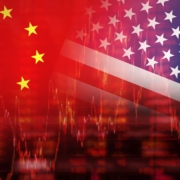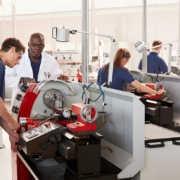Industrial Policy Must Protect American Manufacturers
On November 29, 2021, the Peterson Institute for International Economics released a 110-page brief, titled “Scoring 50 Years of US Industrial Policy, 1970–2020,” which reviews “lessons learned from half a century of US industrial policy” with regard to what worked and what didn’t.
The introduction references Alexander Hamilton’s plan of 1791 to grow domestic manufacturing to “compete with Britain as a producer of manufactured goods for American consumers.” After the War of 1812, Hamilton’s plan became known as the “American System” of Henry Clay, which “consisted of high tariff walls, a central bank and, above all, government investment in ‘public improvements’ like rails, canals, and roads to help industry get goods to customers—the very essence of an industrial policy that some analysts say was crucial to US economic development after the Civil War.”
These “America first” policies remained in effect until after WWII, when we began to enter into trade agreements with many other countries that reduced tariffs and granted non-tariff trade benefits to our trading partners. The briefing states “the debate over the role of the federal government, and especially over tariffs and government spending, has gone back and forth. But by 2020, the US ideological pendulum appears to have swung back in favor of industrial policy for domestic manufacturing.”
Chapter One defines “industrial policy as government intervention against market forces to promote a favored firm or industry,” and the” Tools of industrial policy include easy credit, direct and indirect subsidies, preferential taxes, and tariff and nontariff barriers.” Additionally, “the common objective of US industrial policy is to promote ‘good jobs at good wages’ in the United States.”
The authors believe that “an examination of yesteryear cases may, at a minimum, inject a note of caution, and perhaps yield lessons to improve the design of future episodes.”
In describing their methodology, they said, “we assess individual cases from the perspective of proponents who typically count jobs created or saved, ignoring general equilibrium analysis or the value of human capital gained or lost.” They “selected high-profile federal cases plus a very few (out of hundreds) state cases. We divide the episodes into three broad categories reflecting the principal intervention tools…”
- “cases where trade measures closed the US market or opened foreign markets (chapter 2);
- cases where federal or state subsidies were targeted to specific firms to promote their success (chapter 3); and
- cases where public R&D funds were spent to advance a promising technology (chapter 4).”
For their analysis, they said, “we examine three features of each episode of industrial policy and for each feature assign a letter grade: A, B, C, or D. Numerical equivalents of these grades, used for the summaries in chapter 5, are A+ = 4.5; A = 4; B = 3; C = 2; D = 1. Our assessments were based on answers to the following questions, which reflect contemporary objectives”:
- “Did the industry become competitive in international (or in some cases national) markets? – “an analogous test is whether the industry became competitive in the national market without further public support.
- Were jobs saved in the industry at a reasonable cost to taxpayers or purchasers? – “We do not distinguish between the creation of new jobs or the saving of existing jobs in calculating ‘reasonable cost,’”
- Was the technological frontier advanced through government assistance? – “our assessments are qualitative judgments, not quantitative measures,,,We do not attempt to put a dollar value on technology generated by government programs.”
However, they do note that “our job counts refer only to jobs saved or created in the targeted firm or industry, not jobs lost or gained elsewhere in the economy, and we do not distinguish between skill levels.”
The authors comment that “In the United States, government-driven industrial policy claims a relatively small share of federal and state budgets…All told, the total annual cost of federal industrial policies might reach $100 billion, accounting for 2.4 percent of the annual federal budget. With Biden’s initiatives, this prospective total easily exceeds annual federal industrial policy expenditures during the period covered by this report, 1970 to 2020.”
Chapter 2 considers “Industrial Policy Through Trade Measures” stating that “The use of trade measures—usually protection against imports, but occasionally assistance for exports—is a classic form of industrial policy.” This chapter examines “five high-profile episodes to illustrate the use of trade measures to carry out industrial policy. The episodes concern steel, textiles and apparel, automobiles, semiconductors, and solar panels.” They graded each of these industries according to the above criteria.
I do not have space to provide the data and analyses behind the grades for each of the five selected industries, but am summarizing the grades for each industry:
U.S. Steel industry – rated a “D” for all three of the above criteria.
Textiles and Apparel – rated a “D” for the first two criteria and a “C” for the third.
Automobiles – the ratings were mixed:
- Did trade measures advance the international competitiveness of the US semiconductor industry?
- Rated a “B”
- Did trade measures save jobs at a reasonable cost?
- Rated a “C”
- Did trade measures advance the technological frontier of semiconductor production?
- Rated an “A”
Semiconductors – split ratings for each of the criteria as follows:
- Did trade measures advance the international competitiveness of the US semiconductor industry?
- Failed outcome for the antidumping phase = D;
- intermediate outcome for the market opening phase = B
- Did trade measures save jobs at a reasonable cost?
- Failed outcome for the antidumping phase = D;
- successful outcome for the market opening phase = A
- Did trade measures advance the technological frontier of semiconductor production? Intermediate outcome for the antidumping phase = C;
- successful outcome for the market opening phase = A
Solar Panels – fared better in the ratings:
- Did tax credits advance the international competitiveness of the solar panel manufacturing industry?
- Failed outcome = D
- Did tax credits create jobs at a reasonable cost?
- Successful outcome = A
- Did tax credits (together with the earlier NSF research program) advance the technological frontier of solar panel production?
- Successful outcome = A
As a result, the conclusion was “Analysis of impacts in four US industries—steel, textiles and apparel, semiconductors, and solar panels—shows that trade protection has not been a winning formula for industrial policy, judged by the twin tests of establishing an internationally competitive industry and saving jobs at a reasonable cost to household and business consumers. The main reason, of course, is that sunset industries have been more successful in obtaining trade protection; sunrise industries rarely appeal for new tariffs or quotas. To be sure, trade protection may mitigate the pain of job displacement, but when trade protection endures for a decade or longer, new workers will replace those who retire or quit, thereby prolonging the adjustment process.”
There conclusions may be right for the data they analyzed to answer the questions posed, but I disagree with the questions establishing the criteria for the ratings. In my opinion, the following are the questions that should be asked in establishing industrial policies:
- Are these products part of the military and defense supply chain?
- Are these products important to maintaining the health and welfare of Americans?
- Are these products competing with imports from China or another country within China’s sphere of influence?
- Would it endanger the ability of American manufacturers to produce their products if imports of components and assemblies from China were cut off?
- Would it harm America’s ability to be self-sufficient in producing critical products domestically?
If the answer to any of these questions is “yes,” then whatever policies are needed to protect these domestic industries must be implemented. We cannot defend our country if the products needed by the military and defense industry become unavailable. I don’t just mean the steel needed to produce products for the military. Semiconductors are needed for both military and commercial systems and equipment, as well as textiles and apparel. The COVID pandemic proved that we cannot rely on imports of pharmaceuticals and PPE equipment and supplies to protect the health and welfare of Americans, both military and civilian. The automobile industry doesn’t just make cars for civilian use; they make trucks, tanks, and other military vehicles. Solar panels are used by military bases and government agencies. We need an integrated domestic supply chain if we want to remain a free country. It’s time for all Americans to wake up America to the dangers of being dependent on other countries for manufacturers goods, especially one that has become our enemy – China.









Where are the comments, statements, and pleas from our politicians, ministers, business leaders, and union leaders about asking for all Americans to BUY AMERICAN MADE? There should be daily news items about another plea to buy American. Over and over, stating why it’s everyone’s duty to Buy American. There are some many reasons from, lower taxes, creating jobs, decreasing welfare payments, additional American tax payers and more.
We need to be able to identify the COUNTRY OF ORIGIN for the products on the shelves of our stores and everything sold online. Unfortunately, all our elected officials are only interested in getting reelected. At the rate were going, in the not too distant future, China will be the only superpower left.
Great article, saving and sharing.